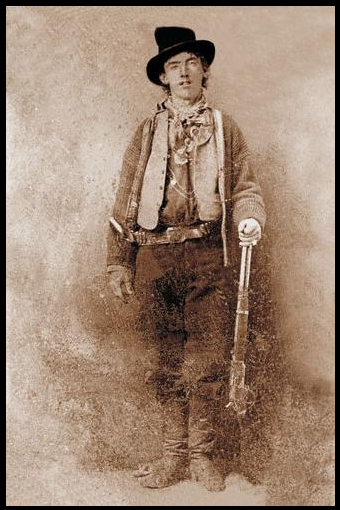One of the most iconic figures that came out of stories of the Wild West was Billy the Kid, also known as William H. Bonney, a gunfighter who entered American folklore and inspired more than one tall tale. His life as a “desperado” has been described in books, film, music, and on stage. A television series ran two years in the early 1960s, depicting Billy as a pretty nice guy–a fabrication that appealed widely to audiences. In every depiction, he is followed by Sheriff Pat Garrett, the man who eventually shot and killed him in Fort Sumner, New Mexico. Billy was 21 years old.
Billy the Kid murdered eight people, lived for a time as a cattle rustler, and when he was first captured by Garrett managed to release himself from handcuffs and shackles, kill two deputies, and escape–some said singing on his horse on his way out. His crimes were written up by the New York Sun. His reputation was enhanced further when a bounty of $500.00 was put on his head. In today’s money, that is equivalent to $11,000.00.
Copland’s “Billy the Kid”
When Aaron Copland wrote his “Billy the Kid: Ballet Suite” in 1938, he saw it as “perception of the pioneer West, in which a figure such as Billy played a vivid role.” It is a marvelous piece, filled with folk tunes and cowboy songs woven into it, and hailed as the beginning of the unique “American sound” in classical music. The music romanticizes Billy, and only much later did Copland observe that had he known the real criminal mindset of Billy the Kid, he might not have written the music at all. But it is a grand piece, and we would be bereft without it. It is an old argument–is something of less value because of the premise that inspired it? Or does creativity require a different dimension of judgment?
Why the Myth of the Cowboy”?
What is a more salient observation, though, is the question of why Americans have absorbed the myth of the gunfighter so absolutely. The degree has varied, but it is a myth that has never been forsaken.
Many years ago I worked on a grant for the National Endowment for the Arts about the last of the cowboys. In the course of it I went with others to Missouri and saw Jesse James’ homestead, a farmhouse that lay in the distance across an open field. I’d grown up watching westerns–it was a thrill to see that legendary place. But that is the power of myth–of believing something that was always in the distance, that sparked the imagination, and brought with a feeling of adventure and action and glamour. For that is exactly what the legends of the cowboys did–brought us into a world that didn’t exist, but we half wished did–a world where we never experienced the same routine, never stayed in one place, always had a new horizon ahead of us. That is the power of myth–that we can be more than we think we are.
But the Truth of It…
The truth of it is we have extolled, valued, remembered, and absorbed legends that belong to killers and thieves, a violent set of characters who lived larger than life, yes, but with the intent to do harm, whenever they had the chance. These were not nice people. For whatever reasons, they were damaged in some way, perhaps even by the relentless westward expansion of America that took no prisoners. We have as our heroes people who would as soon do us in as say hello.
Yet the power of the legends does not fade, even now. Our society is a mirror to the Old West, though we are far ahead of it in time. We visualize violence as a virtue–a hero’s path. Look at 80% of the films and television shows now available. It is a world, in that respect, that has not changed.
The question is–is this the truth we want? Is that why it persists? Or does it signal something else we are unwilling to give up?


